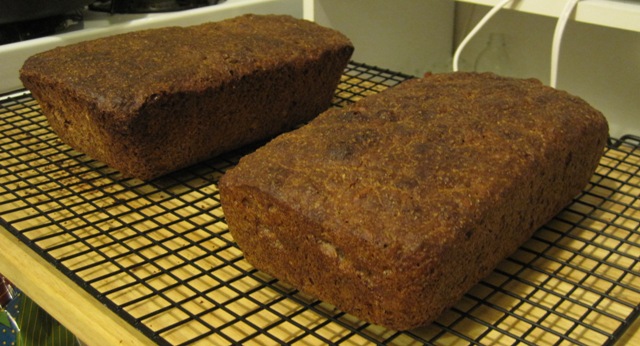Here is the second recipe I've made from Amy's Bread, and my first pumpernickel ever! After having been burned by modifying the methods for the 100% spelt bread recipe (mine ended up VERY sour) in the same book and not knowing what to expect from pumpernickel flour I stayed very close to the original recipe. However, when I put together the final dough, it was absolutely nothing like the description! There is some sort of disconnect here and I'm not sure what it is. The recipe describes a dough that may need to have water added to it a tablespoon at a time if it is too difficult to knead. It describes a dough that should be very easy to handle when it comes time to shape it. My dough was very, very wet and although manageable I would not describe it as easy to handle. I thought that perhaps I measured something wrong, but the final dough weight was in the ballpark of what I expected it to it be after all ingredients were accounted for. My suspicion is that the course pumpernickel flour should have been put in a soaker the night before, as prescribed for the sunflower pumpernickel bread in BBA. My inclination was to make a soaker but I did not because it was not in the recipe as written and I was trying to stay close to the recipe.


These concerns aside, the bread tastes great! The recipe contains a good portion of sunflower seeds and it really seems to go well with the pumpernickel flour. It has a smooth and nutty flavor (duh!) with a pleasingly chewy crumb and a very crunchy crust. I felt like it would have been great with some butter, but I never actually ate it that way... instead preferring to eat the slices plain but lightly toasted. The crunchy crust was undoubtedly helped along because I brushed one loaf with oil and the other with melted butter because I could not fit both loaf pans under my foil pan. This was the suggestion given in Amy's Bread to achieve even coloration if insufficient steam was causing white streaks on your breads. It certainly worked to get a nice even color on top of the loaves, and I did enjoy the crunch imparted on the crust, but at the same time it made the bread a little "oily" like it had been lightly fried or something like that. I'm not sure I'm so keen on that, so I may not use that technique in the future. Perhaps I'll try an egg wash instead?
Also, the loaves were a bit flat because I over proofed them. It's been quite some time since I've made bread with commercial yeast, and being accustomed to sourdough time tables I wasn't keeping a proper eye on the dough. Before I knew it, they were ready for the oven... but it wasn't even pre-heated yet!! Oh well... the taste was still very nice and that is what is important. My next pumpernickel bread will be from BBA so I can compare the two recipes.
- lief's Blog
- Log in or register to post comments
Pumpernickel is a tricky business. Your first attempt certainly could have gone a whole lot worse! Nice job! I've tried a few different recipes, but my dough never seems to quite match the description in the recipe either.
Thank you, Wassisname. Do you suppose there is a lot of variability in the quality of pumpernickel flour? It's not a very easy flour to come by...
will surely give the bread the taste of fried you experienced. I doubt that an egg wash will keep the crust soft, but there are easier tricks: often spray water on the top during baking, after cooking envelope the bread in a film then in a sheet until it cools completely, then remove the film.
Can you post the recipe? Rye breads are generally impossible to knead because the dough resembles wet clay rather than a bread dough, and has to be treated similarly.
Judging from the look your bread must be very tasty!
Sorry Nicodvb, but I don't think I should post the recipe (see the comment below). I have been wondering though, if I start making modifications to a recipe to fit my personal preferences, at what point can I say it is different enough and post it?
It is surely just a language thing, but I don't really understand your comment about "after cooking envelope the bread in a film then in a sheet until it cools completely, then remove the film". Are you suggesting putting plastic wrap around the bread while it cools?
Yes, I was suggesting putting a plastic bag around the bread while it cools. Sorry, english is not my native language;)
I imagine that Amy's Bread carries the same copyright notice that all books do, so posting the precise recipe and instructions should be avoided.
The book is still available at Amazon or through your local library - but I noticed that she has since updated it.
I visited her bakery at Chelsea Market last week. It was fun as we could see part of the mixing, fermenting, and shaping of the dough.
Yes, it has been updated, which is the version that I own. In the introduction she explains that the hydration of many of the recipes in the book have been increased to match what they actually produce in the bakery now since the average baker is now more sophisticated and able to deal with higher hydration doughs. The thought has crossed my mind that the ingredient list was updated for this recipe, but the description was not, and that is why my dough seemed so much wetter than what was described.
I've been to the Chelsea Market bakery as well, and it is something else to see everything going on "behind the scenes".